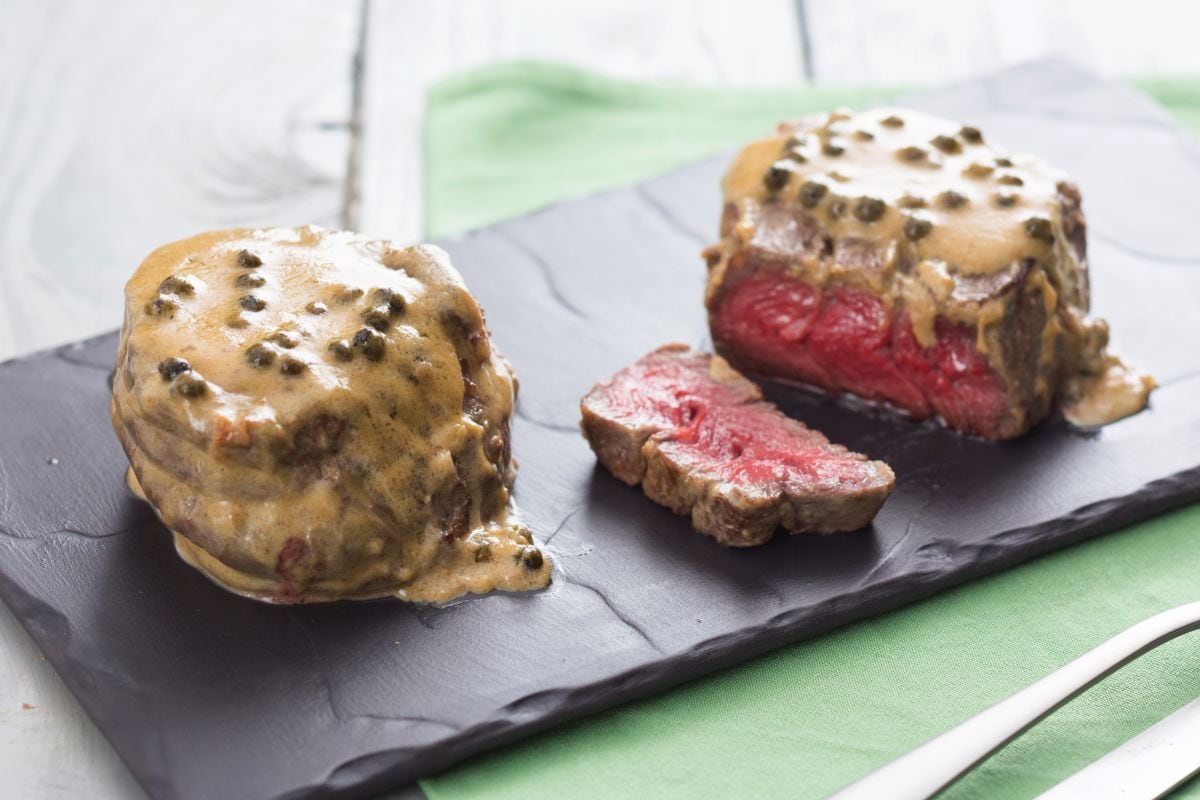Beef cheek with artichokes
- Average
- 4 h 50 min

Who hasn't heard of beef fillet with green peppercorn sauce? Even if you don’t remember the unforgettable ’80s, which brought us some pretty dubious looks and hairstyles, along with timeless classic dishes such as shrimp cocktail and pennette pasta with salmon and vodka, beef fillet with green peppercorn sauce is the sort of classic that is still popular today, especially among meat lovers! This fine cut of beef, which has to be of the best quality since it’s the main ingredient in the recipe, is served drenched in a sauce flavored with green peppercorns that brings a real creaminess and balance to the dish. The sauce itself, made with cream and Dijon mustard, hints at the French origin of this sophisticated dish, although its apparent simplicity actually conceals a few potential pitfalls that can nevertheless be avoided by following our instructions, ensuring that you get the perfect result. The meat in this dish is best cooked rare, but if you’re not a fan of raw meat we recommend that you at least leave the inside nice and pink. Perfect for a romantic dinner or a dinner party with friends, beef fillet with green peppercorn sauce is a contemporary main course with a delightfully retro feel!
If you like this recipe, you could also try:

To make your beef fillet with green peppercorn sauce, first prepare the meat broth following the instructions in our recipe. Meanwhile, take all of the ingredients needed out the fridge to make sure they’re at room temperature, especially the meat, otherwise it could stay cold and raw in the middle. Take some kitchen string and tie the fillets so that they hold their shape better during the cooking process. Cut a fairly long piece of string, fold it in half, and wrap it around the fillet 1, then pass the two ends of the string you’re holding in one hand through the loop in your other hand 2. Now separate the two ends and use them to make another loop around the fillet before securing the string with a knot 3.

After tying the fillets, pour the flour into a container and place the fillets inside 4, taking care to flour only the upper and lower sides 5. Now take a frying pan, add the clarified butter 6 and allow to melt over high heat.

Once the butter is nice and hot, place the fillets in the pan 7, sear them for a few moments over high heat, then lower the heat slightly and let them cook for 1-2 minutes without touching them so that the first ¼ inch (6-7 mm) of the fillet turns golden brown. At this point, turn up the heat again and turn the fillets onto the other side using a pair of tongs or two wooden spoons 8, taking care not to pierce the meat. Sear for a few more seconds, then cook for another 1-2 minutes on lower heat. Finally, turn the fillets on their sides and, raising the heat again, roll them in the butter so that the entire surface is sealed 9.

At this point, add the brandy to the pan, taking care in case the butter splashes 10. Quickly tilt the pan to flambé the brandy, or use a lighter, and let the alcohol evaporate 11. Once the flame is extinguished, lower the heat and add the green peppercorns, having previously drained them from the brine 12,

a pinch of salt, and the mustard 13. Swirl the pan to distribute the sauce, pour in 1.75 oz (50 g) of the fresh liquid cream 14 and ¼ cup (50 g) of broth 15, and turn up the heat once again.

Swirl the pan again to mix everything together, and continue cooking for a couple of minutes, using a spoon 16 to baste the surface of the meat continually with the cream. Then flip them over and do the same thing on the other side. If you like your fillet perfectly rare, touch the surface of the meat with your finger to make sure it's soft. If you prefer your meat a little more cooked, cook it for slightly longer, adding a little broth if necessary. Once the fillets are cooked, transfer them to serving plates, remove the string 17 and let them rest. In the meantime, take the pan containing the cooking juices, add the remaining ¼ cup (50 g) of broth 18

and the 1 oz (30 g) of whipping cream 19, salt to taste, and let the sauce thicken over high heat for 1-2 minutes, swirling the pan as it does so. You’ll recognize the right consistency when you can draw a line through the cream with the spoon and the two sides slowly come back together 20. At this point, take the plate with the fillet, spoon some of the cream over the top, and serve your beef fillet with green peppercorn sauce immediately 21!